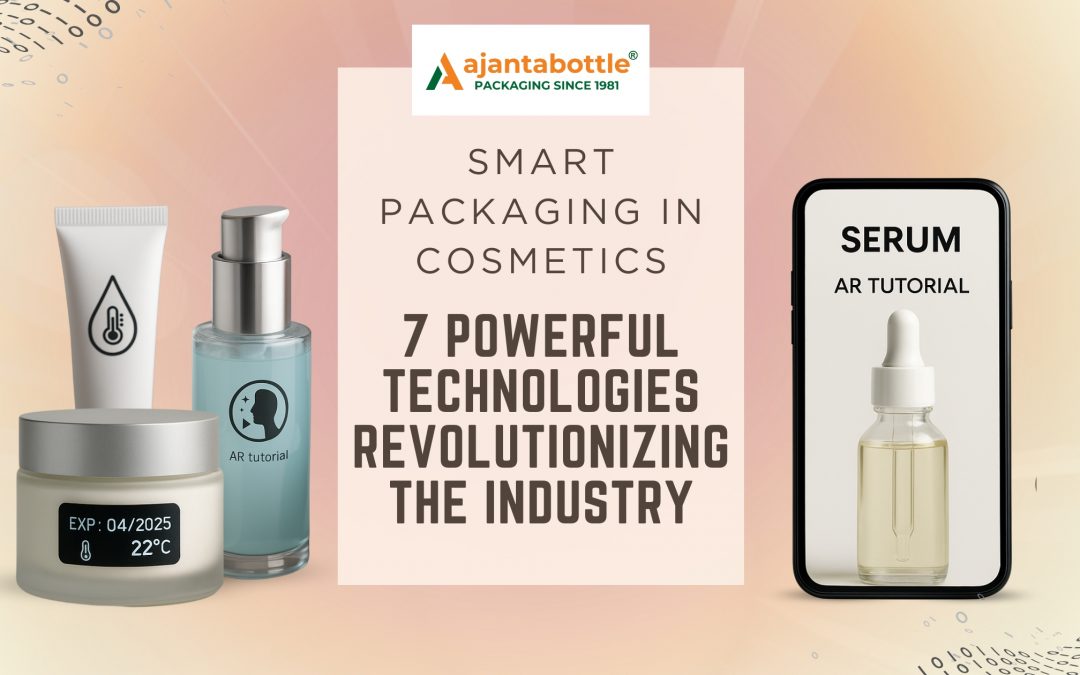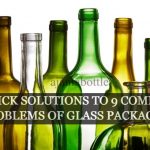The beauty world is getting smarter. As consumers demand more personalization, transparency, and sustainability, packaging is no longer just about aesthetics or functionality—it’s about interaction, innovation, and intelligence. According to Allied Market Research (2024), the global smart packaging in cosmetics market is projected to hit $7.8 billion by 2030. Brands that adopt smart packaging today are not just staying ahead—they’re setting the pace.
In this blog, we explore the most exciting smart packaging in cosmetics technologies, real-world applications by global brands, and how you can integrate these solutions into your own packaging strategies.
What is Smart Packaging in Cosmetics?
Smart packaging refers to packaging that goes beyond conventional functions like holding, protecting, and labeling. It enhances the product experience using embedded technologies to:
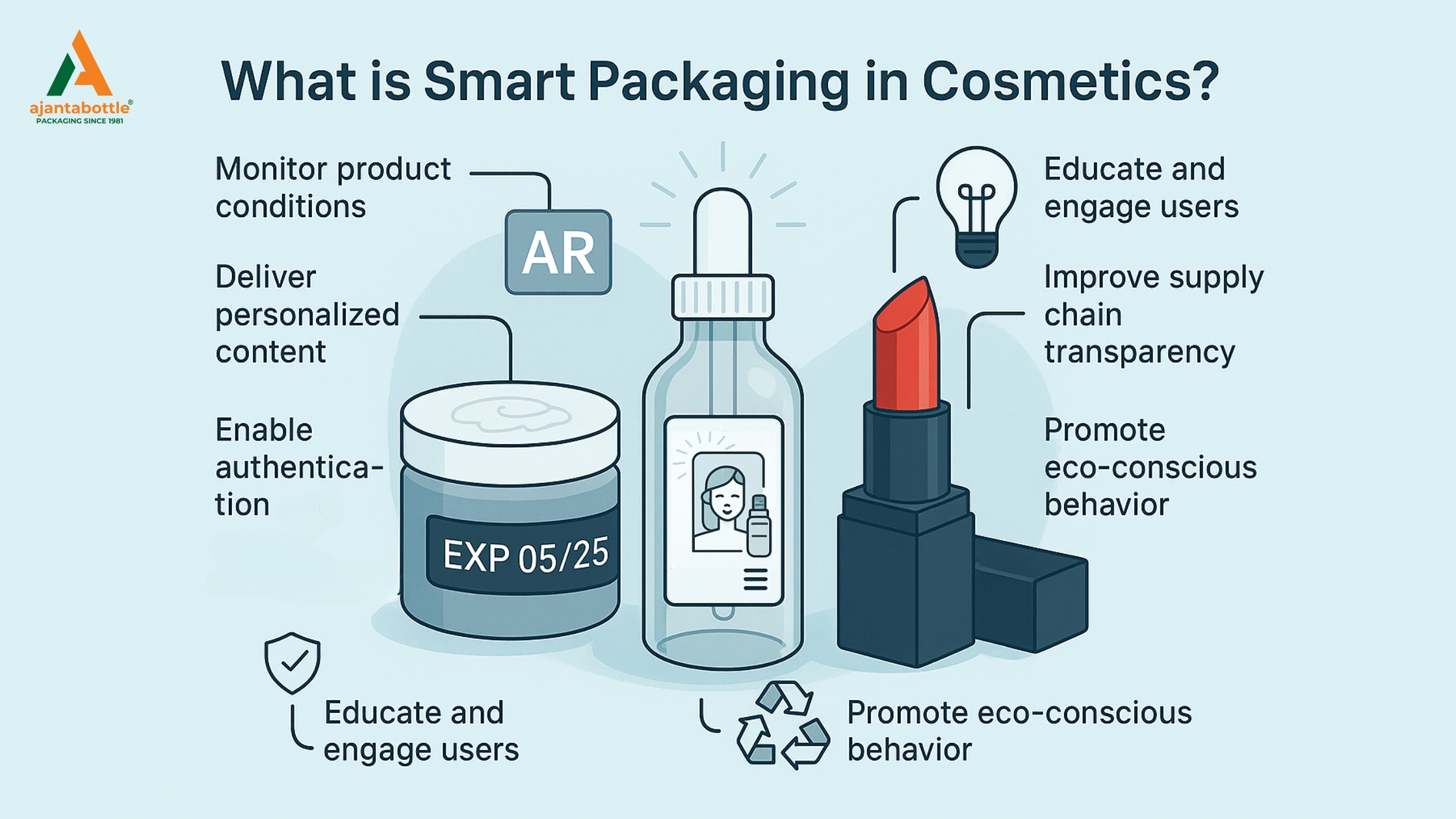
- Monitor product conditions (temperature, humidity, light exposure)
- Deliver personalized content
- Enable authentication and anti-counterfeiting
- Educate and engage users
- Improve supply chain transparency
- Promote eco-conscious behaviorIn cosmetics packaging, this means a moisturizer jar that tells you when it expires, a serum bottle that offers AR tutorials, or a lipstick pack that verifies authenticity via a quick phone tap.
7 Breakthrough Technologies Shaping Smart Packaging in Cosmetics
1. Near Field Communication (NFC)
Used by brands like L’Oréal, NFC tags allow consumers to simply tap their phones on a product to access skincare routines, ingredient breakdowns, or loyalty programs. Easy to integrate and user-friendly, NFC is becoming a baseline smart feature in beauty packaging.
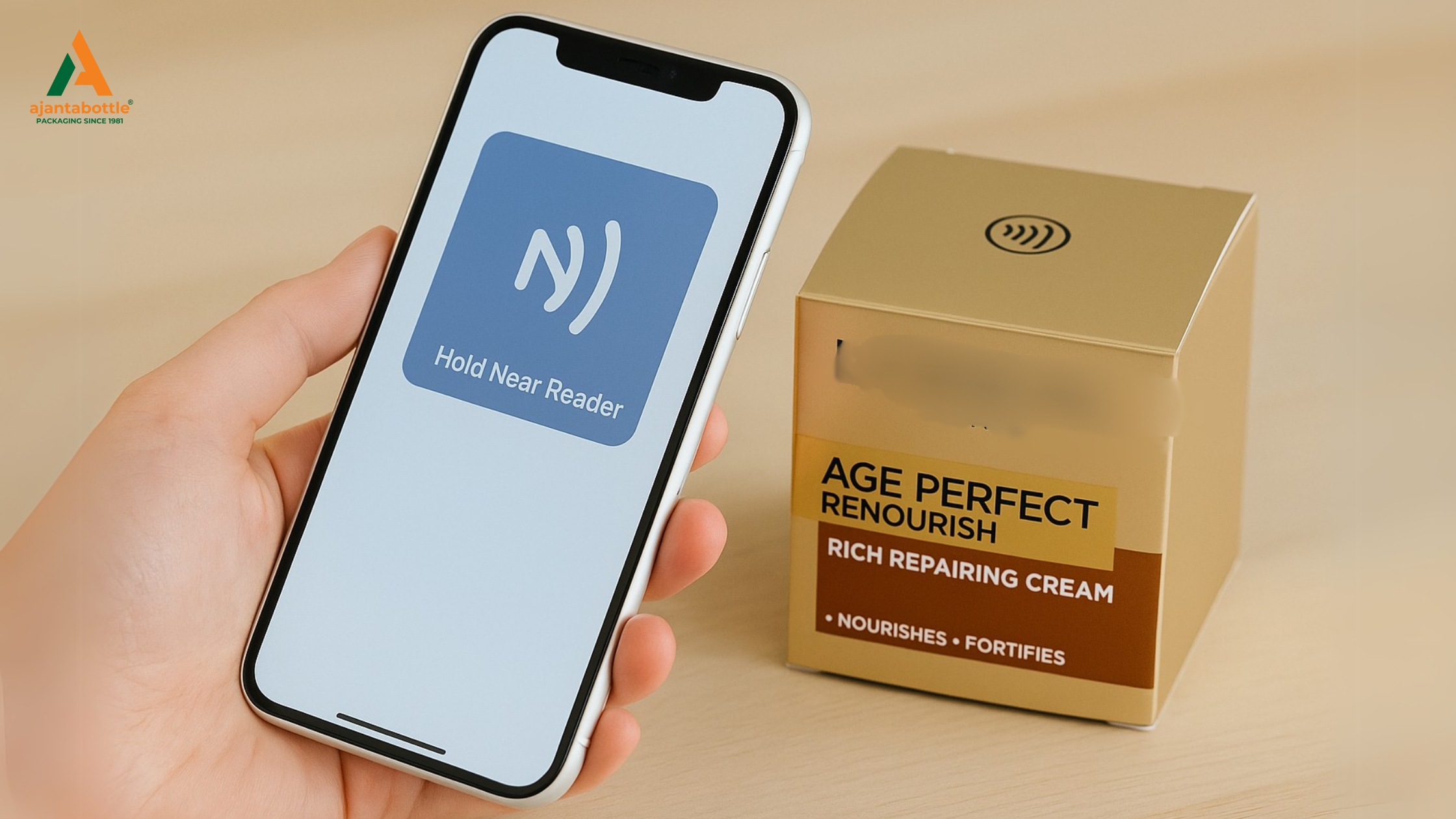
2. QR Codes with Analytics
Beyond linking to product info, QR codes now help brands analyze consumer behavior. Companies like The Ordinary use QR codes for usage guides, recycling info, and to track which content users engage with the most.
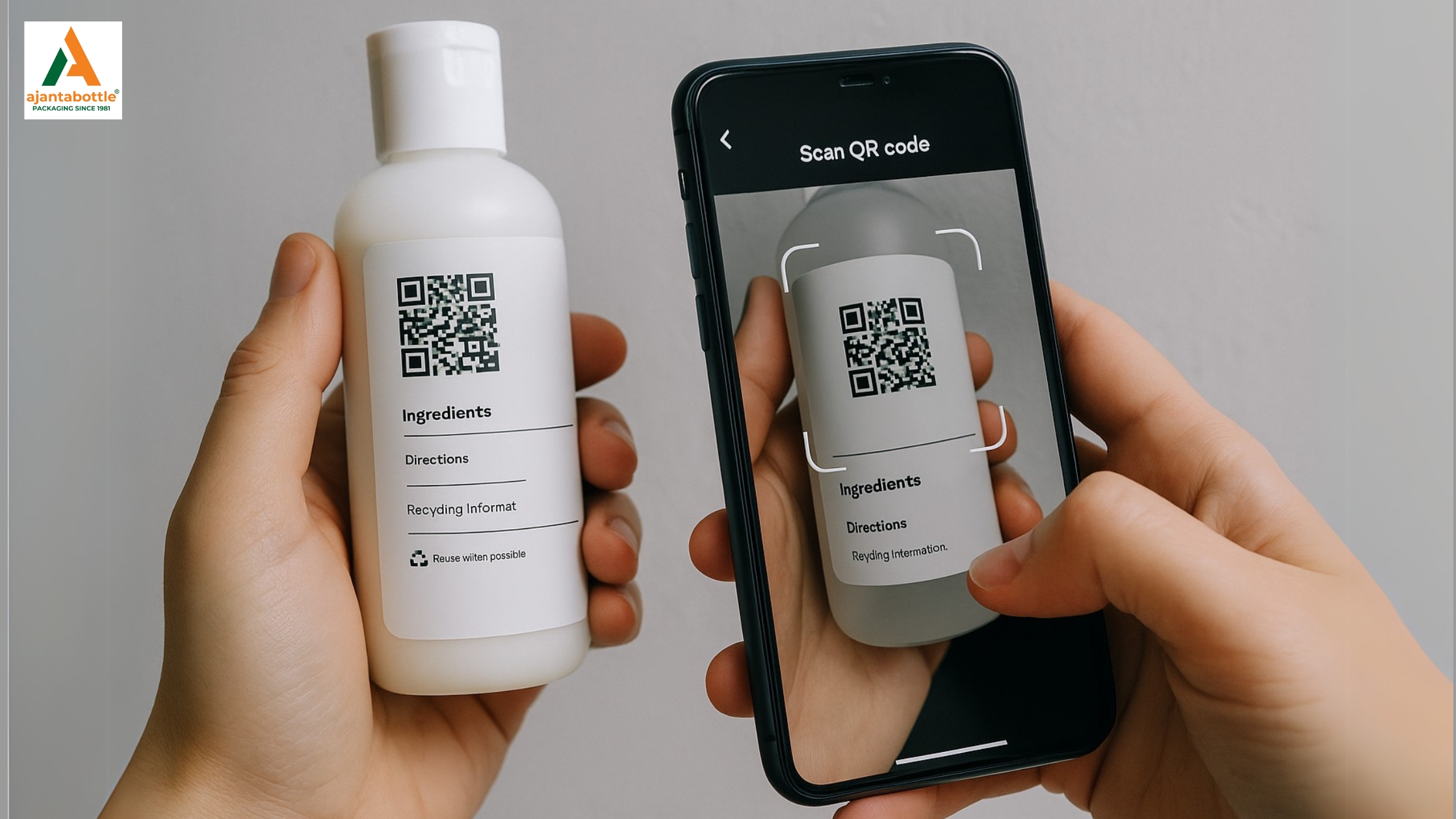
3. Radio Frequency Identification (RFID)
Shiseido and Coty use RFID to monitor inventory and ensure product authenticity across global supply chains. It provides real-time visibility from warehouse to vanity shelf—crucial for premium skincare and cosmetics.
4. Augmented Reality (AR)
Kylie Cosmetics has pioneered AR virtual try-ons that let customers experiment with makeup shades directly through packaging. This reduces returns, improves conversions, and adds a wow factor to the unboxing experience.
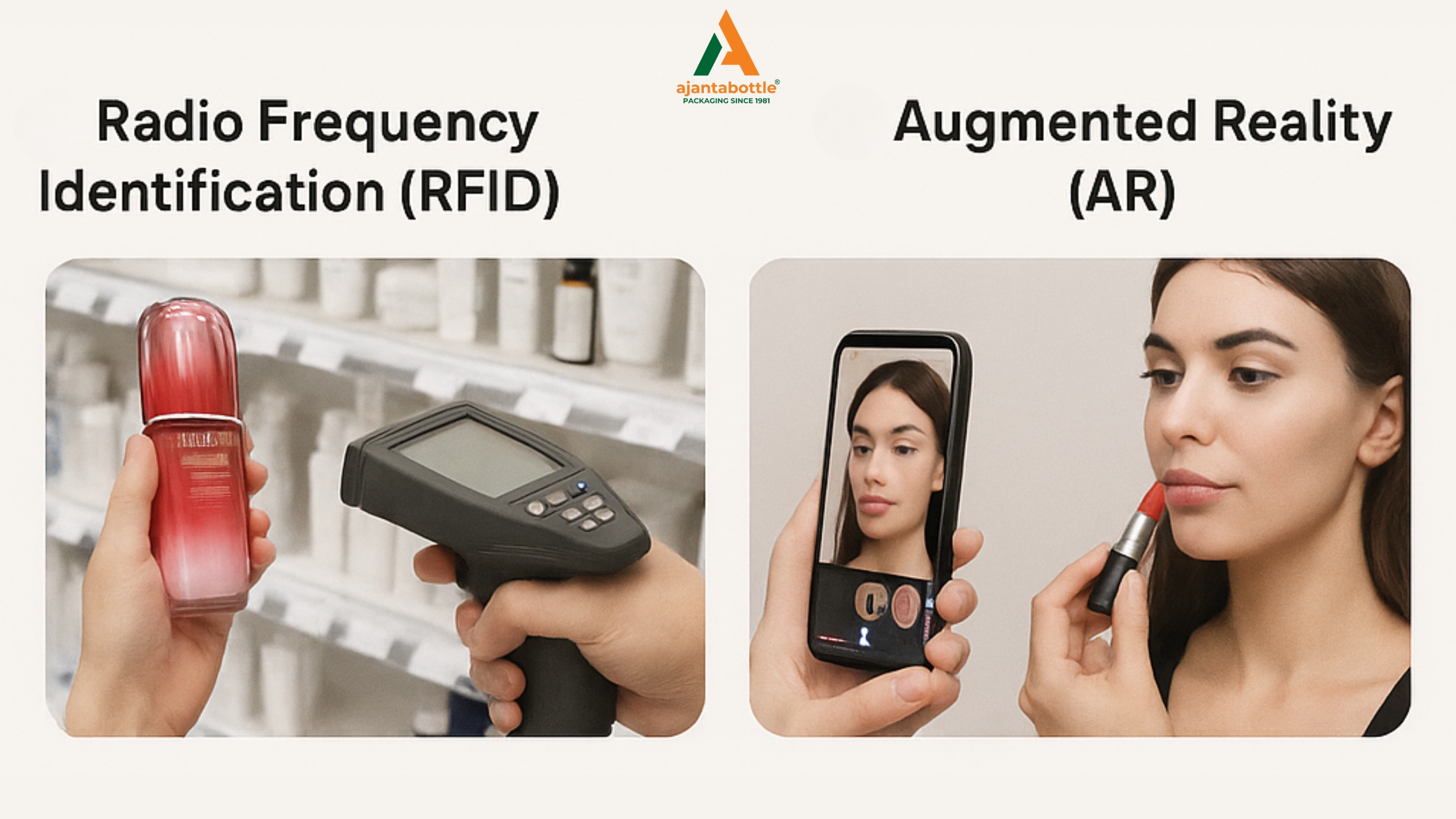
5. Environmental Sensors
Smart bottles with built-in sensors alert users if a serum has been exposed to excessive heat or UV, preserving product integrity. These are particularly helpful for sensitive skincare formulations that require specific storage conditions.
6. AI-Powered Skincare Interfaces
Brands are exploring packaging-integrated AI that offers skincare routines based on live user data—from skin tone to daily weather. The future? A serum bottle that adapts your regimen depending on your skin’s changing needs.
7. Printed Electronics
Flexible circuits printed directly onto packaging enable smart labels, animated messages, or usage trackers without bulky chips. This is a game-changer for sleek, high-design cosmetics packaging.
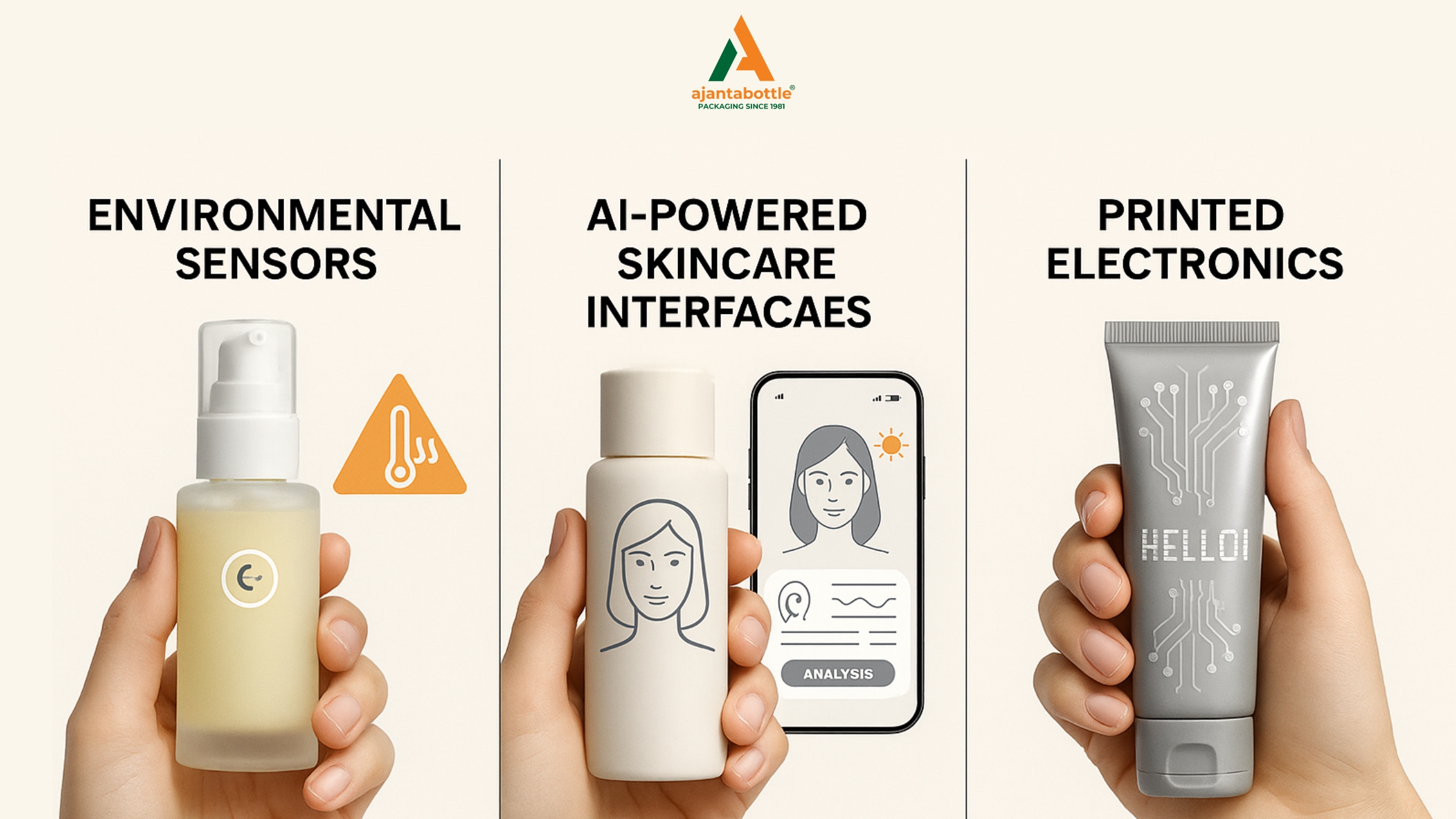
Each technology provides unique benefits, from enhancing consumer engagement to improving supply chain efficiency. The choice of technology depends on the specific needs and objectives of the cosmetics brand. A combination of technologies may be used to create a comprehensive smart packaging solution.
Real-World Applications by Leading Brands
Several cosmetics brands have already embraced smart packaging to enhance their products and engage with consumers.
- YSL Rouge Sur Mesure (2023): Yves Saint Laurent launched a personalized lipstick generator that uses color cartridges and an AI-powered app to create custom lipstick shades on demand. It’s a fully connected device that blends personalization with luxury packaging.
- BoldHue NABS (2024): This brand introduced the Naked Automated Beauty System, a smart foundation shade finder that leverages facial scanning and environmental data to offer hyper-personalized foundation matching, revolutionizing how consumers discover their ideal shades.
- L’Oréal Brow Magic (2023): Developed with Prinker, this at-home electronic brow printer uses AR to scan the face and prints personalized brows directly onto the skin using temporary ink—an innovation combining precision, personalization, and smart tech.
- SKKN by Kim x Opulus (2024): A luxury skincare collaboration that launched smart capsules that blend active ingredients in real time through a rechargeable device—bringing personalization and freshness directly into the consumer’s hands.
- La Roche-Posay My Skin Track UV (2018): This wearable and connected packaging solution includes UV sensors that communicate via NFC to a smartphone app, helping users monitor sun exposure and skin health.
- L’Oréal Perso (2020 concept): A tech innovation that blends skincare, foundation, and lipstick formulation using real-time data and environmental conditions. Though a prototype device, it set the tone for future on-pack intelligence.
These innovations showcase how global and emerging brands are blending cutting-edge tech with everyday packaging to drive trust, boost personalization, and transform the way beauty products are experienced.
Why Smart Packaging in Cosmetics is Becoming Essential?
Smart packaging is no longer a futuristic concept—it’s a necessary evolution in response to how consumers engage with beauty products today. It’s not just a tech trend; it’s the foundation of a new communication layer between brands and buyers. The need for smart packaging stems from four interlinked drivers—each shaping the future of the cosmetic industry.
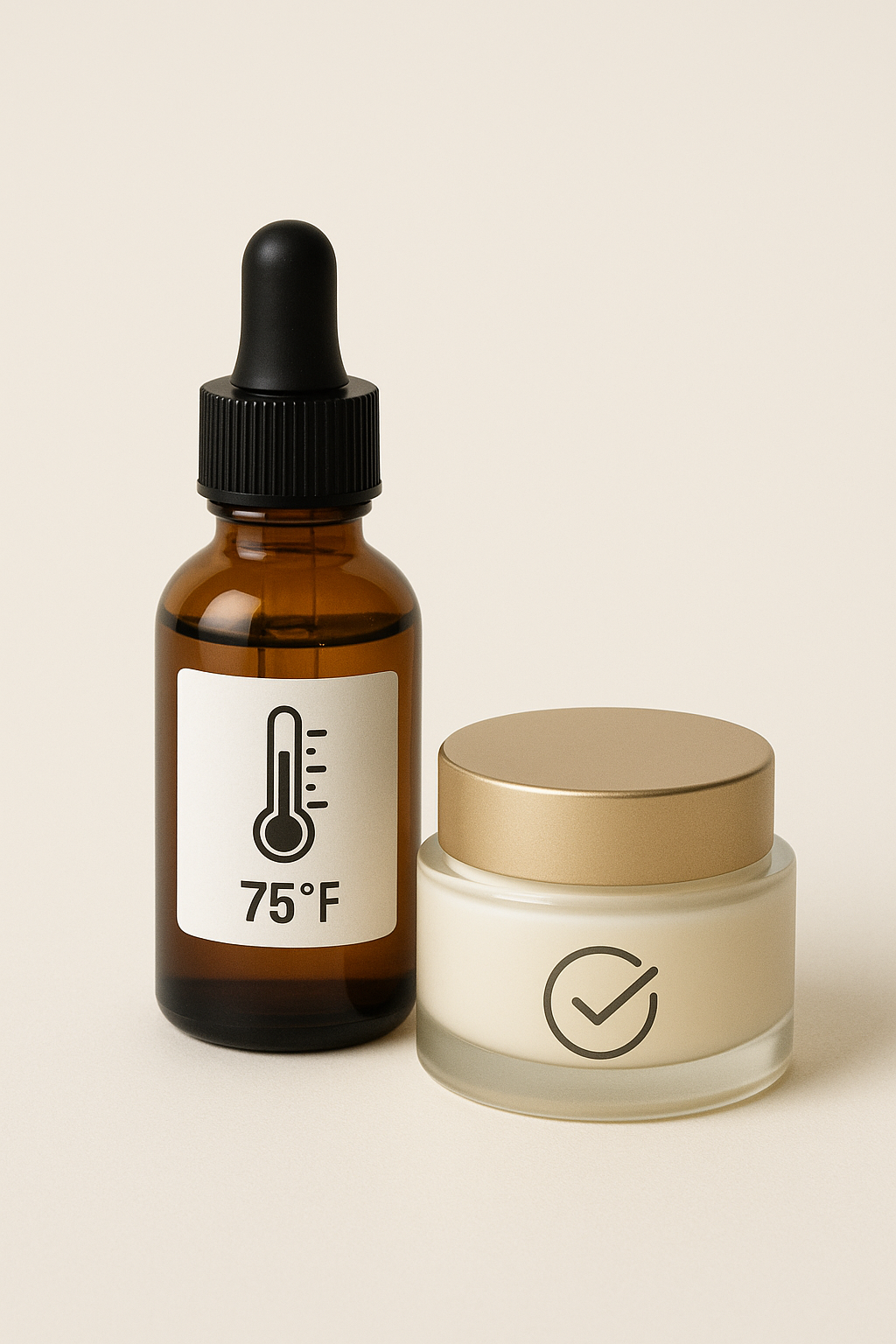
1. Enhancing Functionality and Product Performance
Cosmetic products are sensitive—exposure to heat, light, or air can degrade their quality. Smart packaging helps maintain product integrity through environmental sensors and indicators. Imagine a serum bottle that alerts consumers when stored at harmful temperatures, or a moisturizer jar that changes color when nearing expiration. These added functions ensure better product efficacy and user satisfaction.
2. Enabling Traceability and Authenticity in a Global Market
Counterfeiting and grey market sales are rising threats in the beauty industry. Smart packaging technologies like RFID, NFC, and blockchain-based systems allow brands to trace products across the supply chain and offer consumers instant authentication. This not only prevents fraud but reinforces trust, especially in high-value or luxury segments.
3. Driving Sustainability Through Intelligent Design
Sustainability isn’t just a consumer demand—it’s a regulatory imperative. Smart packaging can include digital instructions for recycling, track carbon footprints via digital product passports, and even support circular models by alerting users when to refill or return packaging. It allows brands to reduce overpackaging while still delivering all necessary information through scannable content.
4. Facilitating Personalized Consumer Experiences
Beauty is deeply personal, and smart packaging in cosmetics allows brands to tailor experiences post-purchase. From QR codes that launch AR tutorials based on skin type to AI-driven dispensers that adjust dosage according to usage behavior, these technologies deepen customer loyalty and differentiate the brand in an overcrowded market.
In essence, smart packaging is not just an enhancement—it’s becoming a strategic pillar in how beauty brands deliver value, ensure quality, and tell their sustainability story.
When implemented thoughtfully, it turns packaging from a single-use container into a powerful interface between the brand, the product, and the consumer’s daily life.
Overcoming Key Challenges in Smart Packaging
1. Cost and Scalability
- Upfront tech investments may seem high, but ROI is driven by reduced product returns, better engagement, and brand differentiation.
- Modular technologies now allow brands to adopt smart features gradually.
2. Technical Complexity
- Lack of in-house tech skills can be solved by collaborating with smart packaging integrators and platform providers.
- Companies like Avery Dennison and Blue Bite are leading in user-friendly, plug-and-play smart packaging systems.
3. Data Privacy and Compliance
- Build consumer trust with clear opt-in experiences.
- Ensure compliance with GDPR and other regional privacy laws through secure cloud platforms.
4. Sustainability vs. Technology
- Brands must balance high-tech with eco-tech. Printed electronics, recyclable NFC chips, and compostable smart materials are emerging rapidly to address this gap.
The Future Outlook: What to Expect
Smart packaging in cosmetics is poised to undergo a transformative evolution by 2030. This future is not about far-fetched ideas, but about achievable innovations grounded in real consumer needs, emerging tech, and sustainability goals. The next frontier will be built on these specific, actionable developments:
The future of smart packaging in cosmetics is bright, with several exciting developments on the horizon:
Smart Packaging with Dynamic Formulation Feedback
Imagine a face cream jar equipped with micro-sensor technology that detects real-time changes in your skin’s hydration or pH levels and sends that data to your skincare app. Based on this, a companion device—or future refill capsules—could adjust the formulation. This level of precision beauty, already being tested in lab settings, could become mainstream by 2030.
Embedded Smart Expiry Systems
Rather than relying on printed expiry dates, future packaging may include visual or digital indicators that track exposure to light, air, and temperature over time—offering a more accurate “live expiry”. For example, color-shifting materials or printed thermochromic strips can visibly show when a product is no longer safe or effective to use.
Biodegradable Interactive Packaging
Eco-tech is advancing to a point where we can expect packaging that is both intelligent and biodegradable. Paper-based NFC tags and compostable printed electronics could offer all the interactivity of current smart solutions, without long-term waste. Companies like PragmatIC and Paptic are already making progress in this area.
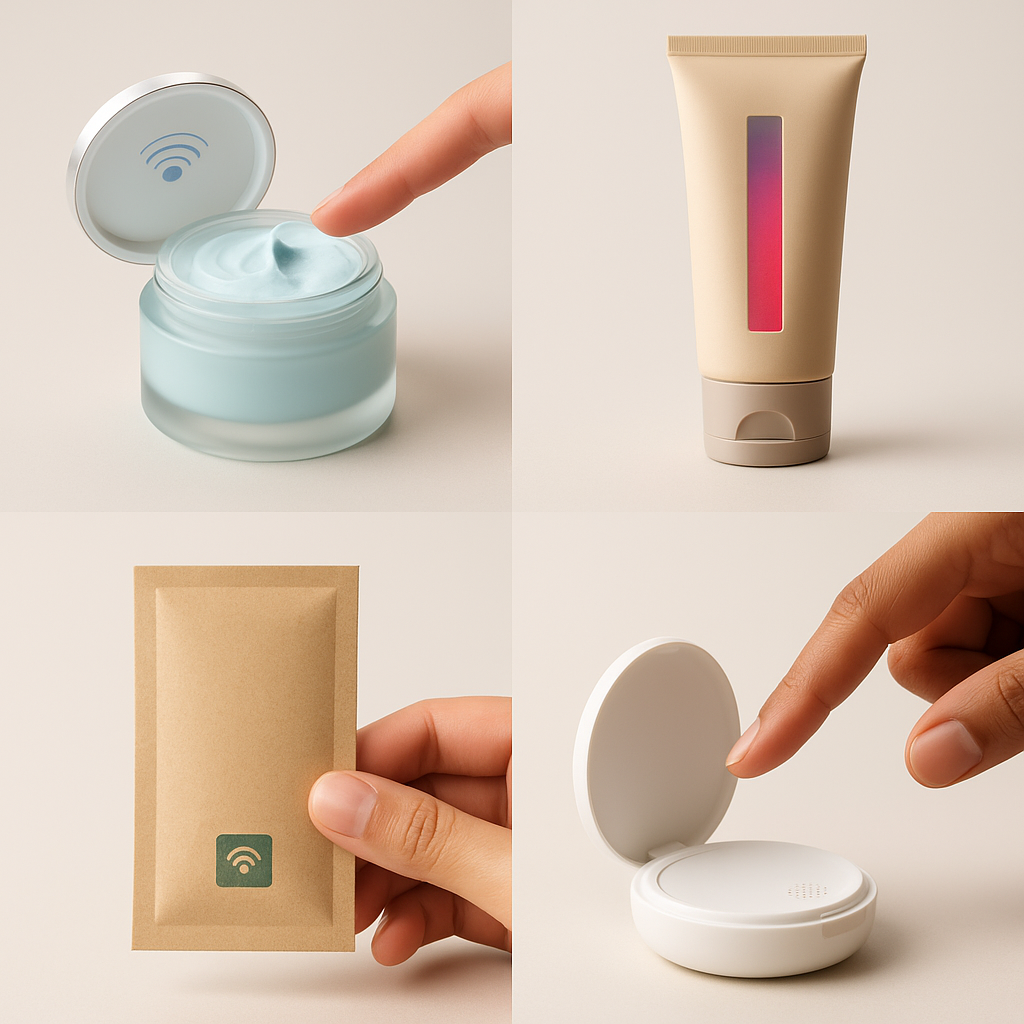
Cross-Brand Smart Ecosystems
Smart packaging in cosmetics could soon enable a connected ecosystem across multiple beauty brands—like Apple’s HomeKit but for beauty. Consumers might manage their skincare routines, track their usage, receive refill alerts, and unlock brand rewards from a single interface regardless of the brand mix they use. This is a significant opportunity for industry-wide collaboration.
Voice and Gesture-Responsive Packaging
Packaging that responds to voice or hand gestures could become standard for inclusive design. This will particularly benefit visually impaired users and is being explored within the broader assistive tech space. A compact that opens with a double tap or serum that plays instructions when spoken to—these are near-future possibilities with current gesture control and printed speaker tech.
The real future of smart packaging in cosmetics isn’t about just being futuristic—it’s about being functionally better, environmentally responsible, inclusive, and brand-agnostic. Each of these innovations represents a tangible leap that beauty brands can work toward in the next five years.. This shift will not only redefine packaging as a utility but position it as a strategic touchpoint that influences user satisfaction, sustainability compliance, and product innovation.
How Ajanta Bottle Supports Smart Packaging in Cosmetics
With over 43 years of experience, Ajanta Bottle has become a trusted name in the packaging industry, offering innovative, high-quality glass packaging solutions to leading cosmetics brands across India and beyond. Our deep understanding of both product aesthetics and technical functionality makes us the ideal partner for beauty brands exploring smart, sustainable, and customized packaging.
Why Beauty Brands Choose Ajanta Bottle:
-
Expertise in Glass Packaging: From perfumes to serums and creams, we provide premium-grade glass bottles and jars that preserve product integrity and elevate shelf appeal.
-
Smart Packaging in cosmetics Compatibility: Our packaging solutions are designed to support next-gen innovations like QR code integration, blending technology seamlessly with glass.
-
Sustainable by Design: All Ajanta glass containers are 100% recyclable and manufactured to minimize environmental impact—aligning perfectly with clean beauty and eco-conscious values.
-
Customization & Branding: We work hand-in-hand with cosmetic brands to deliver tailor-made packaging—from frosted finishes to embossed logos—that stands out and tells your brand story.
-
Trusted by Industry Leaders: Our packaging is used by top D2C beauty startups and heritage brands alike, thanks to our reputation for quality, reliability, and customer-first service.
If you’re looking to elevate your cosmetic packaging with a smart, sustainable, and beautiful solution—Ajanta Bottle is your long-term partner.
Connect with us:
- Email at sales@ajantabottle.com
- Phone/Whatsapp: +91 9891098918
You can also shop from more than 500+ packaging solutions on www.ajantabottle.com – India’s first ever comprehensive packaging e-commerce portal.
For additional information, browse through our blog at https://www.ajantabottle.com/blog/ or subscribe to our latest updates through our social media channels,
*YouTube channel: https://www.youtube.com/c/Ajantabottle
*LinkedIn Page: https://www.linkedin.com/company/ajantabottle
*Facebook Page: https://www.facebook.com/glassbottleindia
*Instagram Page: https://www.instagram.com/ajantabottle/
*Google Business Profile Manager: https://g.page/r/CXTH9MKpe2DuEBM/review

